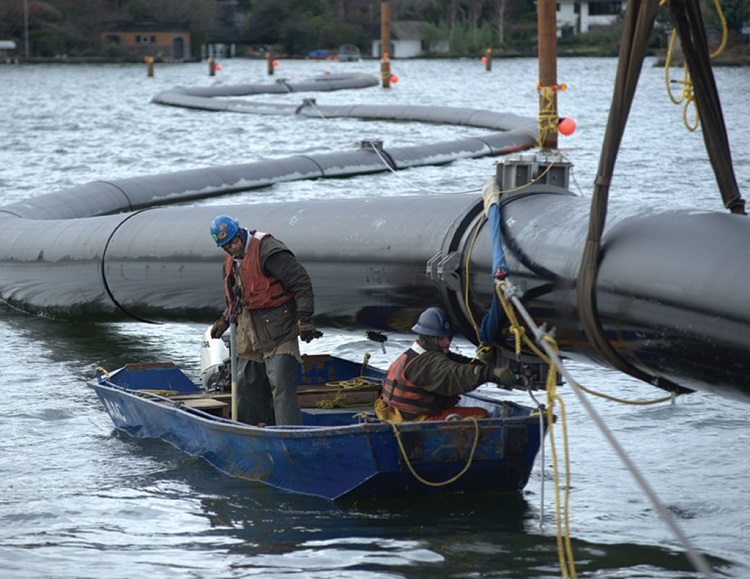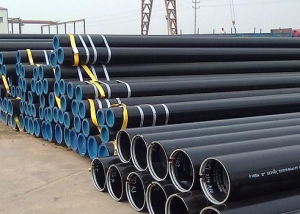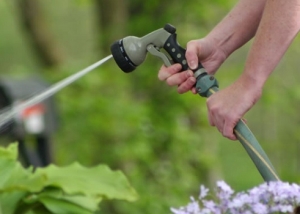Technical characteristics and properties of the HDPE pipe are mainly determined by the material of its manufacture - low-pressure polyethylene. It is a special grade of structural polymers. Products based on it are quite common elements of pipelines (both non-pressure and pressure head) domestic and industrial type. The operational characteristics of such pipes are not inferior to analogues of other materials.
Content [Hide]
- 1 HDPE technology
- 2 Characteristics of HDPE pipes
- 3 Product advantages over analogues
- 4 Classification of HDPE pipes for their intended purpose
- 5 Types of products by properties
- 6 Subtleties of marking communications
- 7 HDPE pipe quality factors
- 8 Features of polyethylene grades
- 9 Installation of HDPE products
HDPE technology
The production of classical polyethylene (PE) is based on the method of polymerization of an organic chemical gaseous compound - ethylene. Under certain conditions, its molecules, when combined, form polymer chains. The end product has unique characteristics.
HDPE production is carried out according to a similar scheme at a pressure of less than 100-2 thousand kPa with a temperature of 120 to 150 degrees. Such conditions are supported in a special pressure chamber. The process requires the presence of a catalyst, for example, an AlR mixture3 with TiCl4.
PND production is possible thanks to three main technologies: gas phase polymerization, the reaction occurring in solution, and the reaction occurring in suspension. For a process in solution (most often in hexane), lasting 10-15 minutes, a temperature of 160-250 ºС and a pressure of 3-5 thousand kPa are characteristic. The separation of polyethylene is carried out in the evaporator, then in the separator, and then in the granulator chamber.
The technology involves steaming the material with water vapor, which has a temperature above the melting value of PE. This is necessary for the transition of low molecular weight fractions into water and the neutralization of catalyst residues. PND is produced in granules or powders and is unpainted or colored.
Characteristics of HDPE pipes
Exposure to a certain temperature and pressure gives PND important qualities. So, pipes from this polymer are characterized by low weight - 900 kg for 1 m3 low pressure polyethylene. Products have a tensile strength of 3-5 thousand kPa.
HDPE pipe has a limited temperature range (working): the lower boundary corresponds to -20 ºС, the upper - +40 ºС. At values below 20 degrees, the material glazes, but does not collapse, and above the permissible limit, it loses ring stiffness. For HDPE pipes low thermal expansion is characteristic.
Note! When heated to 80 degrees (the maximum allowable temperature), the product increases in size by only a few percent.
Pipes of this type are used for cold or drinking water supply, sewerage, and drainage. The specified lines can be mounted either in intra-house communications, or in trenches. And in the latter case depth calculation should be carried out taking into account the freezing threshold of the soil.
Product advantages over analogues
HDPE products have many advantages over pipelines made of other materials. They do not require cathodic protection. Subject to operational requirements and modes of use, the pipe is able to last about fifty years.The high value of the tensile coefficient prevents the product from bursting when freezing water in it. Perfectly smooth surface prevents overgrowing of the pipe inside.

The qualities and properties of HDPE pipes allow them to be laid by ground and underground methods and carry out installation work in any conditions
The low weight of the HDPE (five to seven times lower than steel pipes) allows transportation without any problems, as well as operational pipeline installation. In addition, installation work and the purchase of necessary materials and elements will be cheaper. The pipe does not rust, which greatly simplifies the underground installation of communications, since there is no need for insulation.
HDPE does not interact with water and, accordingly, does not give a metallic taste, does not emit harmful compounds into the surrounding space. Physico-chemical properties of the material allow the use of pipes for the transport of various substances - it is resistant to solvents, acids, alkalis, organic compounds. Products require minimal maintenance and repair.
Classification of HDPE pipes for their intended purpose
Pipes made of polyethylene, which is created under reduced pressure, are classified by purpose and by properties. By purpose, the products are distinguished:
- plumbing;
- gas;
- sewer;
- drainage;
- irrigation;
- casing;
- technical.
Plumbing products are completely blue or black with blue stripes printed along the pipe. PND drinking pipelines are presented with a special list of manufacturing requirements. Gas pipelines - yellow or black with orange or yellow longitudinal stripes.

The purpose of the pipes is easy to determine by their color: yellow products are used in gas supply networks
Sewer models for internal as well as external systems can be made with prefabricated bells, which allows you to make connections without using fittings.
Note! Pipes of this type are also used in the arrangement of collectors.
PND drainage products are distinguished by a special design - corrugated and perfectly drain ground water from buildings and foundations. Irrigation pipes are necessary for watering all kinds of plants, technical pipes - for transporting technical fluids. Casing HDPE models are used to equip water wells. They are not afraid of either natural decomposition, or shifts of soil.
Types of products by properties
Low-pressure polyethylene is a high-density material with good tensile and tensile strength. At the same time, it is plastic and flexible, which makes it possible to produce pressure pipes from it.
So, according to the properties, pipelines are distinguished:
- non-pressure;
- low pressure;
- high pressure;
- for rarefied air conditions.
Non-pressure networks do not have requirements for permissible loads. Usually these are technical systems. Low pressure pipelines should be able to withstand internal pressures up to 5-6 atmospheres. High-pressure communications having a wall up to 7 cm thick can be used at a pressure of 16-20 atmospheres.
The production of pressure products for sewage, gas or water supply is regulated by GOSTs. The documents spelled out the features of manufacturing products, their properties, chemical composition, operational and physical characteristics, and many other parameters.
Subtleties of marking communications
Marking is a mandatory step in the production of HDPE pipes. It is applied to finished products and reflects complete information about a specific product.
The letters "PE" indicate that the pipe is made of polyethylene. They are followed by the designation of the minimum long-term strength, forming, for example, PE 100, PE 32, etc. The SDR coefficient is a relative value, it indicates the permissible load.Next, the value of the outer diameter and wall, expressed in millimeters, is applied.
Note! The purpose of the product is marked in words, it can be technical or drinking.
The pipe also indicates the numbers of state standards by which it is made, information about the manufacturer. In addition to alphanumeric designations, the product is marked with stripes of various colors, reflecting its purpose.
HDPE pipe quality factors
Many technical parameters of pipes depend on the brand of raw materials used, size, SDR coefficient. Today, for the production of products, 4 types of HDPE are used: 63, 80, 100 and 100+. Such a digital index is indicated after the abbreviation "PE" and means the resistance of the wall to constant pressure of gas or liquid, which is transported through the pipe: 63 corresponds to 6.3; 80 to 8; 100 - 10 MPa.

The SDR parameter is the ratio of the diameter of the pipe to the thickness of its wall, the characteristics of the product depend on this parameter
The outer (outer) diameter of the product varies from 1 to 120 cm. The wall thickness also varies widely. The manufacturer does not select the choice of specific values of these parameters arbitrarily - using special coefficients Standard (S) Dimension (D) Ratio (R). This system determines the acceptable ratio of wall to diameter and looks like this: SDR 41; thirteen; 21; 26; 13.6; 9; 6; 17; eleven; 17.6; 7.4.
The ring stiffness of the products also depends on the parameter. With a large planned load and a significant diameter of the PND pipe, it is necessary to carefully select the necessary size ratio. Its small value will lead to the consumer not receiving the required volume of liquid; very large - to the risk of violating the integrity of the thin wall under the influence of pressure.
Features of polyethylene grades
First of all, brands of raw materials differ in their molecular composition. For example, PE 100 has a higher density and elasticity; therefore, pipes made of such a material have better technical characteristics than HDPE products from earlier modifications (63, 80).
Note! The use of an earlier brand of polyethylene does not indicate a lack of quality of the finished product. Just later modifications are more technological and modern.
In the PND standard 18599, pipes can be traced that similar-sized products, but made of polyethylene 100, can withstand more pressure than similar ones from polyethylene 80. In addition, for the production of communications with similar operational characteristics, less PE 100 raw materials will be required than 80 (for account of thinner wall).
Pipes from grade 80 are easier to melt with their own hands, since the diffusion of molecules requires a lower temperature. Grade 100 has a grouped crystalline structure, which makes it better for welding. Such pipes are most often installed in extreme conditions, since they are characterized by greater rigidity.
Installation of HDPE products
Various types of pipes can be mounted on the network in several ways:
- compression fitting;
- bell-shaped;
- electrofusion fitting.
The first method is used to connect HDPE products in systems with low pressure (sprinklers, water pipes). It assumes availability compression fittings with clamping nuts. Installation and fastening to the pipe is carried out using a wrench and a little physical effort. Such a connection is more reliable than a bell-shaped one and can be removed at any time.
The main area of use for bell joints is pressureless communications (pressureless sewage). It is important that the pipes have bell sockets and o-rings.
The electric-welded-fitting connection is one-piece and is performed using a welding machine and special fittings. Such a joint is the most durable, therefore it is used in pressure gas and water systems.
HDPE communications are high-quality and reliable products that can be used to install many types of pipelines.









